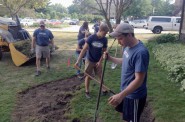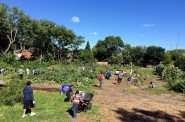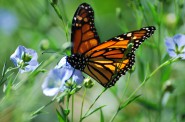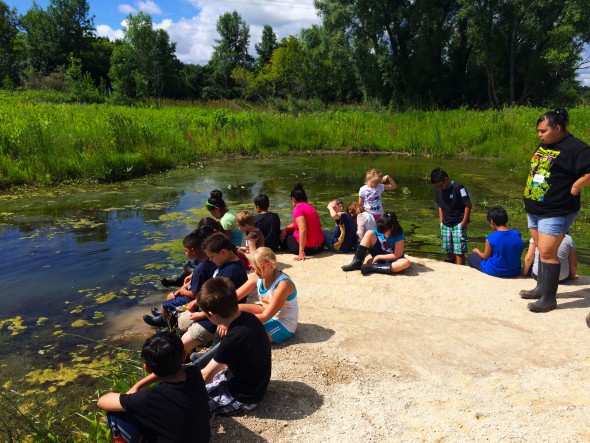Mequon Nature Preserve Battles Water Pollution
MMSD gives group its Green Luminary award in recognition of these efforts.
Many metro area residents don’t realize it, but most water pollution in the region — about 90 percent — comes from “non-point pollution.” That happens when stormwater sweeps up dog and bird feces, lawn and garden fertilizers, road and sidewalk salt, automobile oil spills and other pollutants. Ninety-five percent of that tainted water ends up untreated in area waterways. With that in mind, the Milwaukee Metropolitan Sewerage District (MMSD) has created its monthly Green Luminary Award to recognize area groups that find ways to reduce water runoff of any kind. Rather than letting all the stormwater, polluted or not, rush toward area waterways and the MMSD during rain storms, the goal is to handle and treat water where it falls.
Bill Graffin, public information manager for MMSD, says this is the second year they’ve issued Green Luminary awards. “It’s an acknowledgement for doing the right thing,” he says. “We create videos that demonstrate what people are doing to preserve water and we make them available on our website.”
Previous award winners include Summerfest, Outpost Natural Foods, Mandel Group and the UW-Milwaukee Library. This month’s winner is the Mequon Nature Preserve.
The preserve is a 438-acre area in the City of Mequon that features a beech and maple forest from before the Europeans settled the area, a working farm, a recently restored wetland, an observation tower and education center that informs visitors about preserving nature. It boasts five miles of hiking trails through forests, wetlands and prairies.
Efforts to conserve water and prevent pollution fit the center’s mission nicely. “We have a campus of green infrastructure,” says executive director Kristin Gies she says. “Rain barrels, green roof, a bio cistern,” all features that capture rainwater where it falls. “We’re basically a 438-acre sponge. It’s a pretty impressive sponge, if you will.”
Gies says they have a 500-gallon cistern to help water the landscape. The parking lot floods regularly but now has a portion that’s permeable and allows the water to flow into the ground rather than into sewers. All told, the Nature Center captures about a quarter million gallons of water during a storm,.
”It’s all a fascinating hands-on experiment,” says Gies. “Wherever the rain falls, you have an opportunity to handle it. As development happens in Mequon, we become a more vital tool for our drinking water” by capturing water in its cistern, for example, and thus relying less on the city for water.
Graffin says the Mequon Nature Preserve is an excellent example of the numerous things you can do to manage water where it falls. “The more things we do help keep water out of our rivers, sewers and ultimately reduce water pollution is our goal. We have to prevent water from rolling downhill and into creeks and streams.”
Graffin says every business, non-profit or individual can find ways to reduce water pollution and waste: “There are a ton of different examples. Poblocki paving is one instance where they’ve created a porous parking lot that redistributes tens of thousands of gallons of water during a storm. The water is soaked up by the driveway and sidewalk and there is typically a bed of stone underneath. It helps water percolate into the ground.”
The MMSD says it takes a lot vision and foresight to sustainably manage water where it falls and it’s really about “harvesting rainfall” and finding a cleaner and more managed usage of it.
For individuals, “rain barrels are a good example of something a homeowner can do,” Graffin says. “You capture rainwater from your roof and use it later when it’s dry outside to give thirsty gardens, flowers and trees a drink.” The rain barrels capture 55 gallons of water every time it rains. Homeowners can create a direct flow into their gardens. Graffin says there is a link on the MMSD website indicating where you can purchase these barrels.
Other Luminary Award winners include the City of Milwaukee, Alverno College, Poblocki Paving and the Mitchell Park Domes.
Additional components of a green infrastructure include rain gardens, green roofs and bioswales. “Bioswales are designed to remove silt and pollution from water runoff,” Graffin says. “They’re part of the landscape.”
Graffin says a large part of the MMSD’s current focus is education and creating awareness of the program. Getting people to understand how we all play a part in improving the waters, lakes that belong to all of us.
Is there reason to be optimistic, to believe younger people will join in this effort? “Reason to be optimistic? Yeah. Certainly gaining traction,” Griffin says. “Need more. Need more commitment.”
Graffin says the MMSD has selected an award winner for May and he’s in the process of creating a video for the website. Visit this site to view the efforts and successes of previous winners.
Green Luminaries
-
St. Francis Leads the Way
 Oct 18th, 2016 by Jim Cryns
Oct 18th, 2016 by Jim Cryns
-
Victory Garden Initiative Values Rainwater
 Sep 23rd, 2016 by Jim Cryns
Sep 23rd, 2016 by Jim Cryns
-
Butterfly Supporters Help Environment
 Aug 19th, 2016 by Jim Cryns
Aug 19th, 2016 by Jim Cryns





















